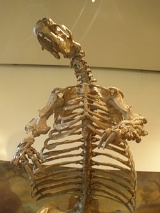
Glossotherium
Encyclopedia
Glossotherium was a genus of ground sloth
. It was a heavily built animal with a length of about 4 metres (13.1 ft) snout to tail-tip, and could potentially assume a slight bipedal stance.
 Fossils of this animal have been found in South America
Fossils of this animal have been found in South America
. It is closely related to Paramylodon
of North America, whose specimens have often been confused and assigned to Glossotherium, which in turn was initially assigned to Mylodon. The earliest Glossotherium specimens are known from the Pliocene
of South America and are represented by the species, G. chapadmalense. All specimens of Pleistocene age are typically lumped into G. robustum and a few other questionable species. Further research is needed at the species level.
Due to its size and strength, Glossotherium would have had few natural enemies apart from sabre-toothed cats such as Smilodon
. It is believed to have died out in Pleistocene
(1.8 million - 12,000 years ago).
Sloth
Sloths are the six species of medium-sized mammals belonging to the families Megalonychidae and Bradypodidae , part of the order Pilosa and therefore related to armadillos and anteaters, which sport a similar set of specialized claws.They are arboreal residents of the jungles of Central and South...
. It was a heavily built animal with a length of about 4 metres (13.1 ft) snout to tail-tip, and could potentially assume a slight bipedal stance.

South America
South America is a continent situated in the Western Hemisphere, mostly in the Southern Hemisphere, with a relatively small portion in the Northern Hemisphere. The continent is also considered a subcontinent of the Americas. It is bordered on the west by the Pacific Ocean and on the north and east...
. It is closely related to Paramylodon
Paramylodon
Paramylodon is an extinct genus of ground sloth of the family Mylodontidae endemic to North America during the Pliocene through Pleistocene epochs, living from around ~4.9 Mya—11,000 years ago .-Overview:...
of North America, whose specimens have often been confused and assigned to Glossotherium, which in turn was initially assigned to Mylodon. The earliest Glossotherium specimens are known from the Pliocene
Pliocene
The Pliocene Epoch is the period in the geologic timescale that extends from 5.332 million to 2.588 million years before present. It is the second and youngest epoch of the Neogene Period in the Cenozoic Era. The Pliocene follows the Miocene Epoch and is followed by the Pleistocene Epoch...
of South America and are represented by the species, G. chapadmalense. All specimens of Pleistocene age are typically lumped into G. robustum and a few other questionable species. Further research is needed at the species level.
Due to its size and strength, Glossotherium would have had few natural enemies apart from sabre-toothed cats such as Smilodon
Smilodon
Smilodon , often called a saber-toothed cat or saber-toothed tiger, is an extinct genus of machairodonts. This saber-toothed cat was endemic to North America and South America, living from near the beginning through the very end of the Pleistocene epoch .-Etymology:The nickname "saber-tooth" refers...
. It is believed to have died out in Pleistocene
Pleistocene
The Pleistocene is the epoch from 2,588,000 to 11,700 years BP that spans the world's recent period of repeated glaciations. The name pleistocene is derived from the Greek and ....
(1.8 million - 12,000 years ago).

